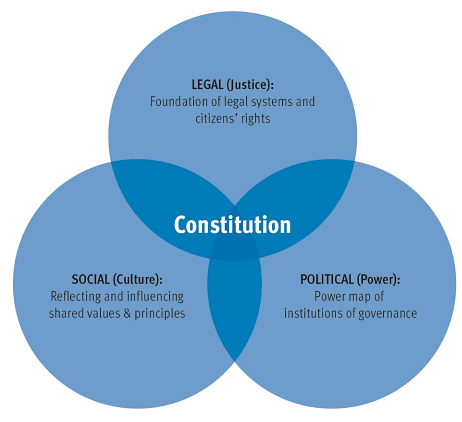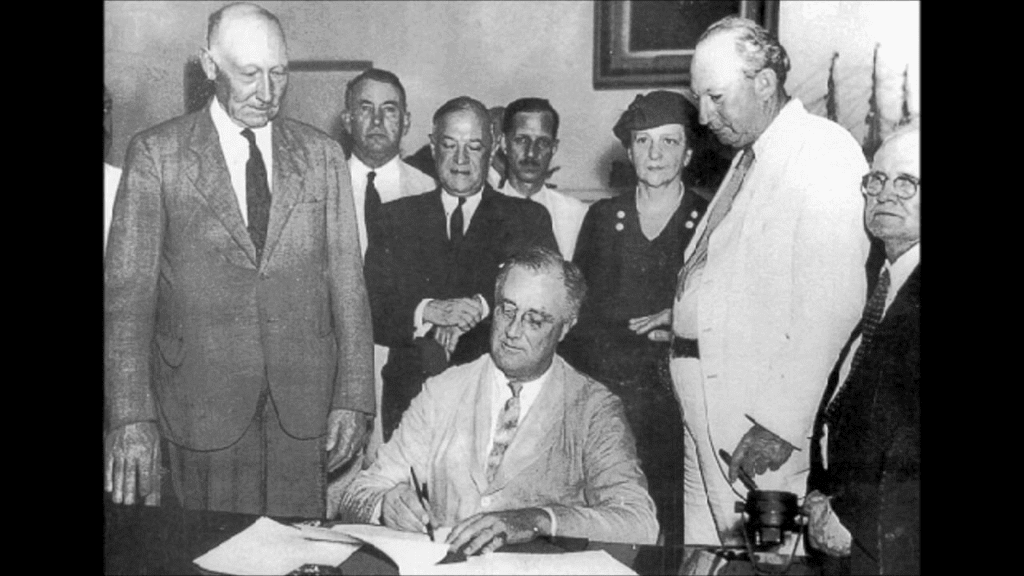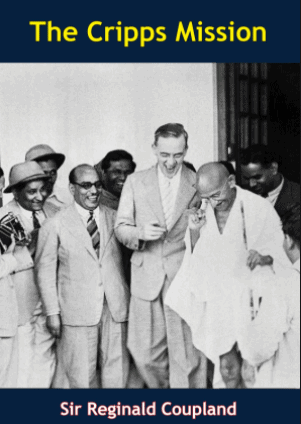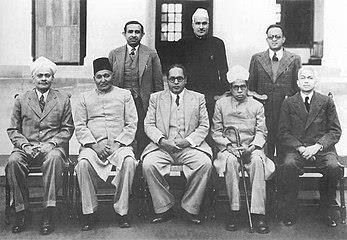History, Features & Sources of Indian Constitution | Legal Reasoning for CLAT PDF Download
Introduction
A constitution is the supreme law of the land, serving as the fundamental legal framework that defines the structure, powers, and functions of the government, as well as the rights and duties of its citizens. It establishes the basic rules for governance, ensures coordination among members of society, and sets limits on governmental authority. The constitution represents the vision, values, and aspirations of a nation’s people, as articulated by its founding fathers. It is a legal, social, and political document that outlines the framework for the government’s principal functions and regulates the relationship between the state and its citizens.
 A constitution is a legal, social and political document
A constitution is a legal, social and political document
Functions of the Constitution
The constitution lays down the basic structure of the political system under which a nation’s people are governed. Its key functions include:
- Providing Basic Rules: Establishes rules to ensure minimal coordination among members of society.
- Decision-Making Authority: Specifies who has the power to make decisions in a society, delineating the roles of the legislature, executive, and judiciary.
- Limits on Government: Sets boundaries on governmental authority to protect citizens’ rights.
- Fulfilling Aspirations: Enables the government to meet the people’s aspirations and create conditions for a just society.
Branches of Government
1. Executive Branch
- The President is the head of the Executive Branch.
- The President is responsible for enforcing national laws.
- The President appoints the Prime Minister, who is the head of the Government.
- The Prime Minister selects other ministers to help run the Government.
- This branch also includes various departments and agencies that carry out specific tasks, such as the Ministry of Health or the Department of Education.
2. Legislative Branch
- The Legislative Branch is responsible for making laws.
- It is made up of two houses: the Rajya Sabha (Council of States) and the Lok Sabha (House of the People).
- Members of the Lok Sabha are elected by the public, while members of the Rajya Sabha are appointed by the State Legislatures.
- This branch debates and votes on proposed laws, known as bills.
3. Judicial Branch
- The Judicial Branch interprets laws and ensures they are applied fairly.
- It is headed by the Supreme Court, which is the highest court in the country.
- The Supreme Court has the power to review laws and declare them unconstitutional if they violate the Constitution.
- Lower courts, such as High Courts and District Courts, handle cases at regional and local levels.
The constitution defines their powers, demarcates their responsibilities, and regulates their relationship with each other and with the people.
 Branches of government
Branches of government
History of the Indian Constitution
The evolution of the Indian Constitution is a product of historical, political, and social developments, shaped by India’s colonial experience, nationalist movements, and the efforts of the Constituent Assembly. Below is a detailed account of its historical development:
Pre-British and Early Governance Systems
Before British rule, India was governed by monarchical systems with fluid state boundaries that changed with rulers. The monarch embodied the rule of law, acting as the legislature (lawmaker), executive (head of state), and judiciary (final court of appeal). Ancient Indian governance, as seen in the Mauryan and Gupta empires, relied on customary laws and texts like the Arthashastra (Kautilya) and Dharmashastra, which provided principles of justice and administration. The Mughal era introduced centralized rule with a blend of Islamic and customary laws, but no written constitution existed.
British Colonial Reforms
The British arrival marked significant changes in India’s governance structure, laying the groundwork for constitutional development through a series of legislative reforms:
- Regulating Act, 1773: Established the office of Governor-General and centralized British administration under the East India Company, marking the first step toward structured governance.
- Pitt’s India Act, 1784: Introduced a dual system of control by the British government and the East India Company, enhancing oversight over Indian administration.
- Charter Acts (1813, 1833, 1853): Expanded British control, introduced legislative councils with limited Indian participation, and laid the foundation for modern governance structures.
- Government of India Act, 1858: Transferred governance from the East India Company to the British Crown after the 1857 Revolt, establishing direct British rule and the office of the Viceroy.
- Indian Councils Acts (1861, 1892, 1909): Gradually introduced Indian representation in legislative councils. The Minto-Morley Reforms (1909) introduced separate electorates for Muslims, a precursor to communal representation.
- Montagu-Chelmsford Reforms (1919): Introduced diarchy in provinces, granting limited responsible government to Indians, though criticized for insufficient powers.
- Simon Commission (1927): A British initiative to review constitutional reforms, boycotted by Indians for lacking Indian representation. It led to the Nehru Report (1928), drafted under Motilal Nehru, proposing a dominion status constitution with Fundamental Rights and a federal structure.
- Round Table Conferences (1930–1932): Discussions between British officials and Indian leaders on constitutional reforms, largely unsuccessful due to disagreements, particularly between the Indian National Congress (INC) and the Muslim League.
Government of India Act, 1935
- Background: The act was based on a report by Lord Linlithgow in 1934. The British Parliament passed a bill from this report, which aimed to create a federation of British provinces and Princely States, although the joining of Princely States was voluntary.
- Diarchy: The act introduced a system called diarchy at the national level. In this system, the Governor-General controlled crucial departments like Foreign Affairs and Defence. Other federal subjects were managed by the Governor-General with advice from an appointed council of ministers. The Governor-General held the residuary powers.
- Federal Legislature: The federal legislature was bicameral, comprising the Council of States and the Federal Assembly. In the provinces, diarchy was replaced by provincial autonomy, leading to a fully responsible government.
- Federal Court and Reserve Bank: The act established a Federal Court with the authority to interpret the constitution and a Federal Bank, known as the Reserve Bank of India. The Indian Council of Secretary of State was dissolved.
- Electoral Changes: The act extended the principle of separate electorates to include Anglo-Indians, Christians, and Europeans. Elections for the provincial legislature were conducted under this act in 1937.
 The Government of India Act was passed by the British Parliament in August 1935
The Government of India Act was passed by the British Parliament in August 1935
Importance of the Act
- The Government of India Act, 1935 was crucial in laying the groundwork for India's future governance.
- It introduced key concepts of federalism and provincial autonomy, which are integral to the Constitution.
- The act's provision for a Federal Court set a precedent for judicial review, a critical aspect of the Constitution.
- By extending electoral rights, it paved the way for a more inclusive political system.
Cripps Mission, 1942
- During World War II, Sir Stafford Cripps was sent to India by the British government to seek Indian cooperation in the war effort against Germany.
- The Cripps Mission in 1942 aimed to offer India greater self-government in return for support during the war.
- However, the proposals did not grant effective power to Indians during the war period.
- The mission was deemed a failure as Indian leaders rejected the proposals put forth by Cripps.

Cabinet Mission 1946
Post-World War II, the British government sent three cabinet ministers to resolve India’s constitutional question. The Cabinet Mission proposed:
- A three-tier federal structure: Union, Groups of Provinces, and Provinces/Princely States.
- A Constituent Assembly to draft the constitution, with representation based on population (1 member per million).
- Rejection of the Muslim League’s demand for a separate Pakistan but allowed provinces to form autonomous groups.
- The mission outlined the procedure for the Constituent Assembly and aimed for a united India.
The mission failed to reconcile Congress and Muslim League demands, leading to communal tensions and eventual partition.
Mountbatten Plan (1947)
Proposed by Lord Mountbatten in June 1947, this plan finalized the partition process:
- Divided British India into two dominions: India and Pakistan, effective August 15, 1947.
- Provided for the division of Punjab and Bengal and referendums in areas like Sylhet and the North-West Frontier Province.
- Led to the Indian Independence Act, 1947, passed by the British Parliament, which:
1. Declared India and Pakistan as independent dominions.
2. Abolished the office of the Viceroy and created Governors-General for both dominions.
3. Granted full legislative authority to the Constituent Assembly to frame India’s Constitution.
Constituent Assembly (1946–1949)
The Constituent Assembly, established under the Cabinet Mission Plan, was tasked with drafting India’s Constitution:
Composition: Comprised 389 members (292 elected from Provincial Legislative Assemblies, 93 nominated by Princely States, and 4 from Chief Commissioners’ Provinces). Notable members included Jawaharlal Nehru, Vallabhbhai Patel, Dr. B.R. Ambedkar, Maulana Abul Kalam Azad, and Dr. Rajendra Prasad. Mahatma Gandhi and Jai Prakash Narayan were not members.
Key Committees:
- Union Powers Committee (Chair: Jawaharlal Nehru): Defined Union government powers.
- Union Constitution Committee (Chair: Jawaharlal Nehru): Outlined the Union government structure.
- Provincial Constitution Committee (Chair: Vallabhbhai Patel): Designed state government structures.
- Advisory Committee on Fundamental Rights, Minorities, etc. (Chair: Vallabhbhai Patel): Framed Fundamental Rights and minority protections.
- States Committee (Chair: Jawaharlal Nehru): Facilitated the integration of Princely States.
- Drafting Committee (Chair: Dr. B.R. Ambedkar): Prepared the final draft of the Constitution.
 Dr. Babasaheb Ambedkar, chairman, with other members of the Drafting Committee of the Constituent Assembly of India, on 29 August 1947.
Dr. Babasaheb Ambedkar, chairman, with other members of the Drafting Committee of the Constituent Assembly of India, on 29 August 1947.
Working of the Constituent Assembly
- The first meeting of the Constituent Assembly took place on Dec 9, 1946, with Dr. Sachidanand Sinha as its interim President.
- Dr. Rajendra Prasad was elected as its President on Dec 11, 1946.
- The Constituent Assembly reassembled on August 14, 1947, as the Sovereign Constituent Assembly for the Dominion of India.
- Dr. B.R. Ambedkar was appointed Chairman of the Constitution Drafting Committee.
- B.N. Rao was appointed Advisor to the Assembly.
- It took 2 years 11 months and 18 days to finalize the constitution.
- The draft constitution of India was submitted to the President of the assembly on 21 February, 1948.
Enactment of the Constitution
- The Constitution was adopted on Nov 26, 1949, which is also known as the Date of Passing.
- The constitution thus adopted contained a Preamble, 395 articles, 18 parts and 8 schedules in all.
- The provisions regarding citizenship, elections and provisional parliament were implemented immediately, i.e. from November 26, 1949, while the rest came into force on January 26, 1950, known and celebrated as the Republic Day of India.
Objectives Resolution
- The historic Objectives Resolution was moved by Pt. Jawahar Lal Nehru on December 13, 1946, which was finally adopted by the assembly on January 22, 1947, and took the form of ‘Preamble’ to the constitution.
National Flag
- Adopted by the Constituent Assembly on July 22, 1947. Its design was proposed by Pingali Venkaiah of Andhra Pradesh.
National Anthem and National Song
- Adopted on 24 th January 1950. Jan Gan Man (by Rabindranath Tagore) was selected as the National Anthem while Vande Matram (by Bankim Chandra Chatterjee in his novel Anand Math) was selected as the National Song. Jan Gan Man was first sung at the Congress Session, Calcutta in 1911.
Sources of the Indian Constitution
The Government of India Act, 1935 formed the basis or ‘blueprint’ of the Constitution of India with its features of the federal system, office of governor, etc.
Besides this, the Indian Constitution has borrowed from many other sources:
- Britain: Influenced the parliamentary system, rule of law, law-making processes, the office of the Comptroller and Auditor General (CAG), and the concept of single citizenship.
- USA: Contributed ideas for the Preamble, Fundamental Rights, Judicial Review, independence of the judiciary, and the notion of a written Constitution.
- Ireland: Inspired the Directive Principles of State Policy, the election process for the President, and nominations to the Rajya Sabha.
- Canada: Provided the idea of a quasi-federal system and residual powers.
- Former USSR: Introduced the concept of Fundamental Duties.
- Australia: Contributed to the Concurrent List and regulations regarding trade, commerce, and intercourse, as well as the languages used in the Preamble.
- Weimar Constitution of Germany: Influenced the suspension of fundamental rights during emergencies.
- South Africa: Contributed to the procedure for constitutional amendments.
Indigenous Sources
- Ancient Indian Texts: Concepts of justice and governance from Arthashastra (Kautilya) and Dharmashastra, emphasizing duties of rulers and social order.
- Buddhist and Jain Principles: Non-violence and equality influenced Fundamental Rights and Directive Principles.
- Gandhian Philosophy: Decentralization (Article 40, Panchayati Raj), prohibition (Article 47), and promotion of cottage industries (Article 43).
- Indian National Movement: Demands for equality, self-rule, and social justice shaped the Constitution’s vision of a sovereign, democratic republic.
- Nehru Report (1928): Proposed Fundamental Rights, a federal structure, and responsible government, influencing the Constituent Assembly’s deliberations.
- Russian Revolution (1917): Inspired the ideas of social, economic, and political justice in the Preamble.
Salient Features of the Indian Constitution
- Length and Structure: The Indian Constitution is the longest written constitution in the world, comprising 22 chapters, over 444 articles, and 12 schedules.
- Sovereign Socialist Secular Republic: It declares India as a sovereign, socialist, secular, and democratic republic.
- Fundamental Rights: The constitution guarantees fundamental rights to all citizens, ensuring essential freedoms and rights.
- Directive Principles of State Policy: These principles guide the state in policy-making and aim to promote social and economic welfare.
- Parliamentary System: It establishes a parliamentary system of government with the President as the constitutional head and the Council of Ministers as the real executive, accountable to the Lok Sabha.
- Federal Structure: The constitution is federal in form during normal times but unitary in spirit during emergencies.
- Rigidity and Flexibility: It is neither too rigid nor too flexible; some provisions can be amended by a simple majority, while others require a special majority.
- Single Citizenship: The constitution guarantees single citizenship to all citizens of India.
- Universal Adult Franchise: It introduced universal adult franchise, giving every adult over 18 years the right to vote, and established the system of joint electorates.
- Independent Judiciary: An independent judiciary is established, with the Supreme Court acting as the guardian of the Constitution.
Constitution Review Commission
- In the year 2000, the Government of India set up a Commission led by Justice M.N. Venkatachaliah to assess the functioning of the Constitution and suggest necessary improvements.
Landmark Constitutional Cases
The judiciary has played a pivotal role in shaping the Indian Constitution through landmark judgments that define its scope and protect its core principles:
- Shankari Prasad Case (1951): Affirmed Parliament’s unrestricted power to amend the Constitution, including Fundamental Rights, under Article 368.
- Golaknath Case (1967): Ruled that Fundamental Rights are sacrosanct and cannot be amended by Parliament, emphasizing their inviolability.
- Kesavananda Bharati Case (1973): Introduced the Basic Structure Doctrine, limiting Parliament’s amendment power to protect essential features such as democracy, secularism, federalism, and judicial review.
- Minerva Mills Case (1980): Invalidated parts of the 42nd Amendment that undermined judicial review and skewed the balance between Fundamental Rights and Directive Principles, reinforcing the Constitution’s equilibrium.
- S.R. Bommai Case (1994): Clarified limits on Article 356 (President’s Rule), preventing its misuse, and upheld secularism as a basic structure component.
- K.S. Puttaswamy Case (2017): Recognized the right to privacy as a Fundamental Right under Article 21, expanding the scope of personal liberties.
- Navtej Singh Johar Case (2018): Decriminalized homosexuality by striking down parts of Section 377 of the Indian Penal Code, emphasizing constitutional morality and individual dignity.
Major Constitutional Amendments
Constitutional amendments have adapted the Indian Constitution to evolving needs, balancing flexibility and stability:
- First Amendment (1951): Introduced Articles 31A and 31B to safeguard land reforms and establish the Ninth Schedule, protecting certain laws from judicial review.
- 42nd Amendment (1976): Known as the “mini-Constitution,” it added “Socialist” and “Secular” to the Preamble, expanded Directive Principles, and limited judicial review. Some provisions were later moderated.
- 44th Amendment (1978): Restored judicial review, revised emergency provisions (e.g., replacing “internal disturbance” with “armed rebellion” for National Emergency under Article 352), and reclassified the right to property as a legal right under Article 300A.
- 73rd and 74th Amendments (1992): Strengthened local self-governance by establishing Panchayati Raj institutions and Urban Local Bodies, promoting decentralized democracy.
Contemporary Relevance
The Indian Constitution remains a dynamic framework, adapting to modern challenges through judicial and legislative interventions:
- Constitutional Morality: Advocated by Dr. B.R. Ambedkar, this principle guides courts to uphold justice, equality, and individual rights, as seen in cases like Navtej Singh Johar.
- Living Document: The Constitution evolves through judicial interpretation to address contemporary issues, such as environmental protection (e.g., M.C. Mehta cases) and the right to privacy (K.S. Puttaswamy).
- Cooperative Federalism: Institutions like the GST Council and NITI Aayog foster collaboration between the Centre and States, balancing federal and unitary elements.
Conclusion
The Indian Constitution stands as a dynamic and resilient framework, molded by landmark judicial rulings, key amendments, and its ability to address contemporary challenges. Judgments like Kesavananda Bharati and S.R. Bommai have fortified its foundational principles, while amendments such as the 42nd and 44th have ensured adaptability without compromising stability. As a living document, guided by constitutional morality and cooperative federalism, it continues to uphold justice, equality, and democratic values. Its unique blend of federal and unitary features, alongside India’s distinctive Sarva Dharma Sambhava approach to secularism, sets it apart globally, making it a cornerstone for governance and legal reasoning in India’s evolving socio-political context.
|
63 videos|172 docs|37 tests
|
FAQs on History, Features & Sources of Indian Constitution - Legal Reasoning for CLAT
| 1. What is the Constitution of India? |  |
| 2. What are the salient features of the Indian Constitution? |  |
| 3. What are the sources of the Indian Constitution? |  |
| 4. What is the history of the Indian Constitution? |  |
| 5. What is the order of precedence in India? |  |






















